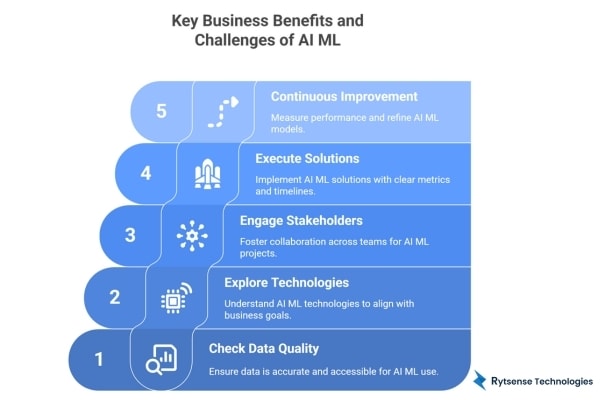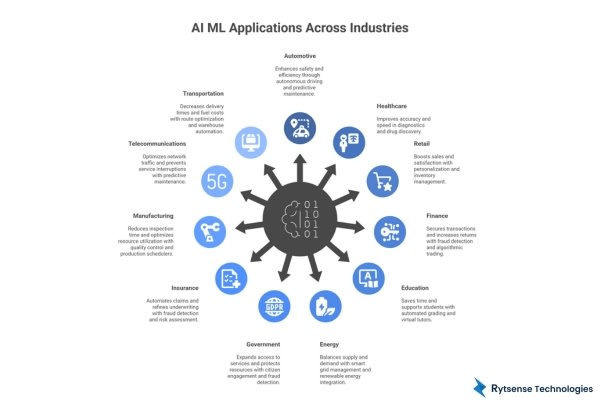-
Key Takeaways
- AI/ ML use cases deliver 40% higher productivity and 30% cost reduction across business operations.
- Customer-facing applications like chatbots and personalization engines significantly improve engagement and reduce support costs by 35%.
- Predictive analytics and maintenance prevent equipment failures, optimize resources, and save millions in operational expenses.
- Industry-specific AI/ ML solutions transform healthcare diagnostics, financial fraud detection, retail personalization, and manufacturing quality control.
- Successful AI/ ML implementation requires strategic planning, stakeholder engagement, quality data, and continuous model improvement for sustainable growth.
The Most Valuable AI ML Use Cases for Business
AI ML implementations revolutionize business operations through smart process automation, predictive analytics, and increased decision-making. Some examples comprise of customer service chatbots, personalized experiences, predictive maintenance, and cybersecurity threat detection. Applications in healthcare, finance, retail, and manufacturing, which can drive higher productivity and significant cost savings. Partnering with a reliable AI ML development company ensures these solutions are implemented effectively.
AI and ML use cases are changing how companies operate, with the global market for artificial intelligence expected to reach $1.8 trillion by 2030, representing a 37.3% annual growth rate. Companies that utilize AI and ML report 40% more productivity while reducing their overall company-wide operating costs by 30%. By understanding the artificial intelligence business use cases, organizations can generate new competitive advantages through the adoption of intelligent automation, predictive analytics, and improved decision-making. Businesses often collaborate with an AI ML development company to maximize these benefits.
Understanding AI ML Use Cases
What Are AI ML Use Cases?
Key Business Benefits and Challenges of AI ML

Checking Existing Data
Exploring AI and ML Technologies
Engaging Stakeholders
Executing AI ML Solutions
Ongoing or Continuous Improvement
Customer-Facing AI ML Use Cases
Deliver Superior Customer Service with AI ML
Customize Customer Experiences Using AI and Machine Learning
Promote Cross- and Up-Selling with Predictive Insights
Introduce Personal Assistants and AI Chatbots
Brighten Up Smartphones with AI Integration
Humanize Human Resources with AI ML Automation
Become an AI Expert in Customer Experience Management
Unlock the full potential of AI and ML for your business with tailored solutions designed to optimize performance and cut operational costs.
Creative and Cognitive AI ML Use Cases
Create with Generative AI and Machine Learning
Deliver New Business Insights with AI ML Analytics
Clarify Computer Vision Applications Across Industries
- Retail stores use computer vision solutions to monitor inventory levels automatically.
- Manufacturers monitor the production process and quickly identify types of defects as they occur.
- Security solutions use computer vision to capture unauthorized access attempts.
Technical AI ML Use Cases
Speed Operations with AIOps and Intelligent Automation
Automate Coding and Application Modernization
Boost Application Performance with AI Optimization
Strengthen End-to-End System Resilience
Enhance Cybersecurity and Threat Detection Using AI ML
Robotics and Industrial Automation
Clean with Predictive Maintenance
See What’s Next with AI ML Predictive Analytics
Industry-Specific AI ML Use Cases
| Industry | Primary Applications | Key Benefits |
|---|---|---|
| Automotive | Autonomous driving, predictive maintenance | Safety, efficiency |
| Healthcare | Diagnostic imaging, drug discovery | Accuracy, speed |
| Retail | Personalization, inventory management | Sales, satisfaction |
| Finance | Fraud detection, algorithmic trading | Security, returns |

Automotive and Autonomous Vehicles
Education and EdTech Innovation
Energy and Utilities Optimization
Financial Services and Banking Automation
Government and Public Sector Transformation
Healthcare and Pharmacy
Insurance Claims and Risk Management
Manufacturing and Industrial AI ML Applications
Retail and E-Commerce Personalization
Telecommunications Network Optimization
Transportation and Logistics Efficiency
Delivering the Promise of AI ML
AI ML Adoption Challenges
Solution Patterns with Rytsense Technologies
Collaborating with Rytsense Technologies’ AI Partners
Building Sustainable and Scalable AI ML Systems
Conclusion
The Future of AI ML Use Cases in Business Transformation
Looking to automate your IT operations or modernize your legacy systems with AI?
We can help you integrate intelligent automation to improve reliability and scalability.
Meet the Author

Karthikeyan
Connect on LinkedInCo-Founder, Rytsense Technologies
Karthik is the Co-Founder of Rytsense Technologies, where he leads cutting-edge projects at the intersection of Data Science and Generative AI. With nearly a decade of hands-on experience in data-driven innovation, he has helped businesses unlock value from complex data through advanced analytics, machine learning, and AI-powered solutions. Currently, his focus is on building next-generation Generative AI applications that are reshaping the way enterprises operate and scale. When not architecting AI systems, Karthik explores the evolving future of technology, where creativity meets intelligence.